Cycle News Staff | January 28, 2016
The Final Countdown: Can the YZ250F reign supreme for a third straight year?
How often have we seen in supercross or motocross that when someone breaks through for their first crown, they tend to stay there for a while—Bob Hannah, Rick Johnson, Jeremy McGrath, Ricky Carmichael and Ryan Villopoto quickly come to mind. Well, the same often happens with motorcycles; case in point, the Yamaha YZ250F. Ever since getting a major overhaul in 2014, the YZ250F has taken over-the-top step of our 250F CN MX Shootout podium, before that, it was the KX250F for a number of years. So the big question going into our 2016 shootout was (just like it was last year), could the Yamaha do it again and make it three successive shootout wins? With major revisions to the KTM, Husqvarna and Suzuki, and strategic updates to the Honda, this was a very legitimate question and one that we took seriously and took our time carefully answering.
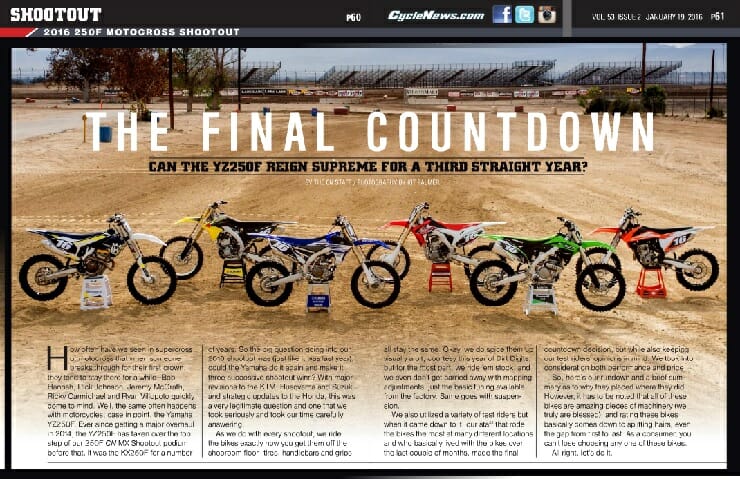
You can read the original magazine story by clicking HERE.
PHOTOGRAPHY BY KIT PALMER
As we do with every shootout, we ride the bikes exactly how you get them off the showroom floor—tires, handlebars and grips all stay the same. Okay, we do spice them up visually a bit, courtesy this year of Dirt Digits, but for the most part, we ride ‘em stock, and we even don’t get carried away with mapping adjustments, just the basic tuning available from the factory. Same goes with suspension.
We also utilized a variety of test riders but when it came down to it, our staff, that rode the bikes the most at many different locations and who basically lived with the bikes over the last couple of months, made the final countdown decision, but while also keeping our test riders’ opinions in mind. We took into consideration both performance and price.
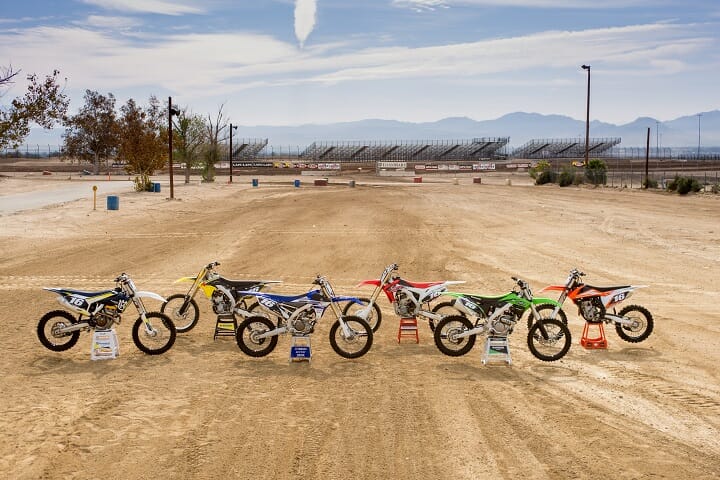
So, here’s our rundown and a brief summary as to why they placed where they did. However, it has to be noted that all of these bikes are amazing pieces of machinery (we truly are blessed), and rating these bikes basically comes down to splitting hairs, even the gap from first to last. As a consumer, you can’t lose choosing any one of these bikes.
All right, let’s do it.
**********************************************
The Contestants…
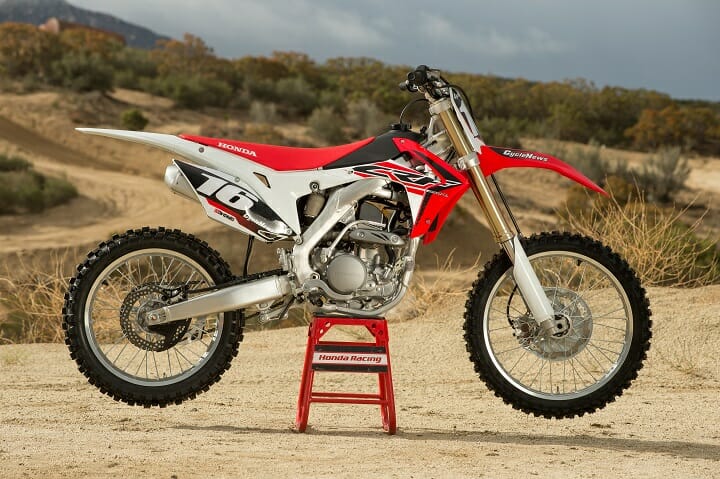
The Honda CRF250R took on a few strategic updates to the motor and suspension for 2016. It has more power and improved handling, and is one of two bikes that is fitted with air forks (the other is the Suzuki).
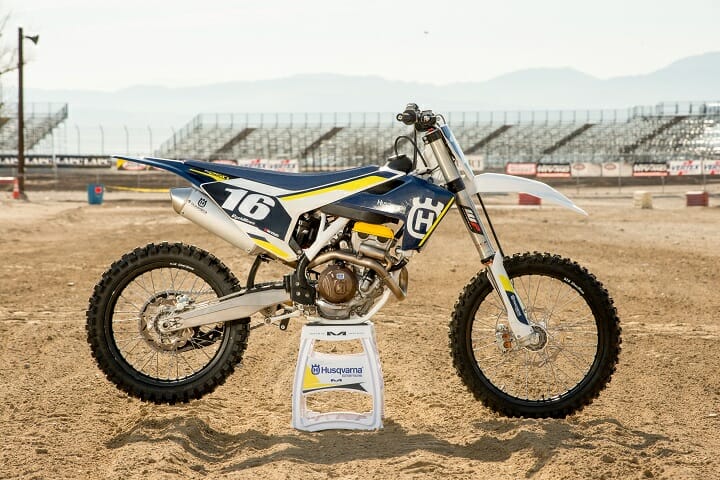
The Husqvarna FC 250 is back and is an all-new machine. You could say that it’s a Husky in KTM clothing, but there are a few minor differences that set them apart, tires, subframe and airbox being the most important ones.
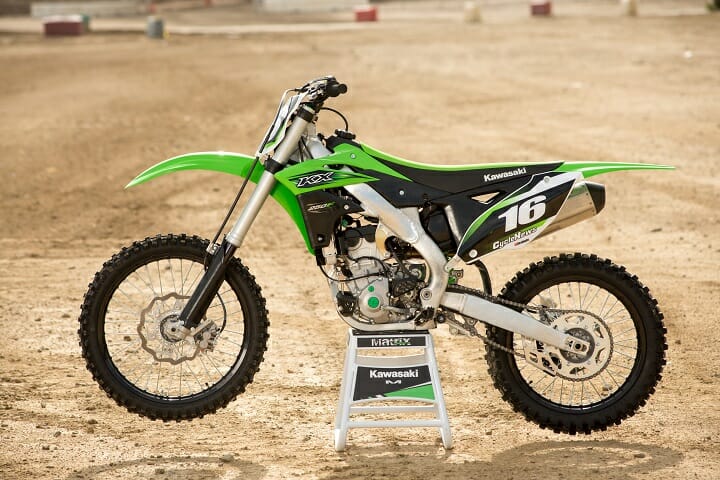
Of the six bikes, the Kawasaki KX250F is the least changed. In fact, it’s not really changed at all. It gets new graphics and a new green-colored rear fender. Luckily for Kawasaki, the KX was already an outstanding performer and is known for its explosive and powerful motor, and super-stable chassis. It is fitted with Showa SFF spring forks.
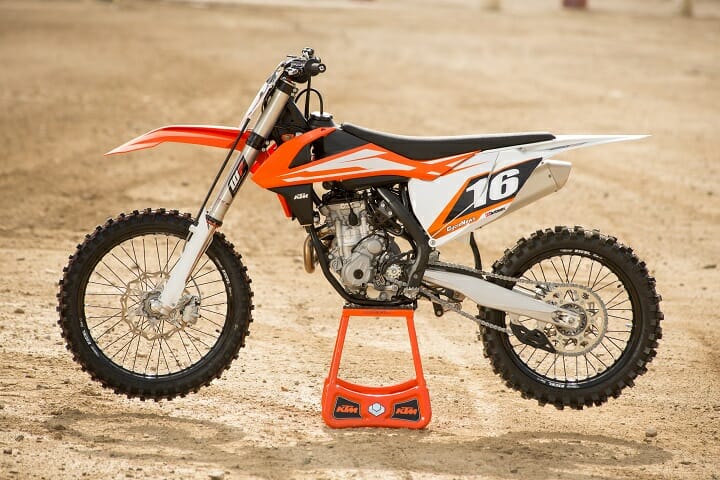
The KTM 250 SX-F, like the Husky, is the most changed from last year. It’s pretty much the same bike as the 2014 limited-edition Factory Edition model. It’s electric starting, hydraulically operated clutch and WP suspension sets it apart from the other four Japanese models. Both it and the Husky carry the highest MSRPs by a significant amount.
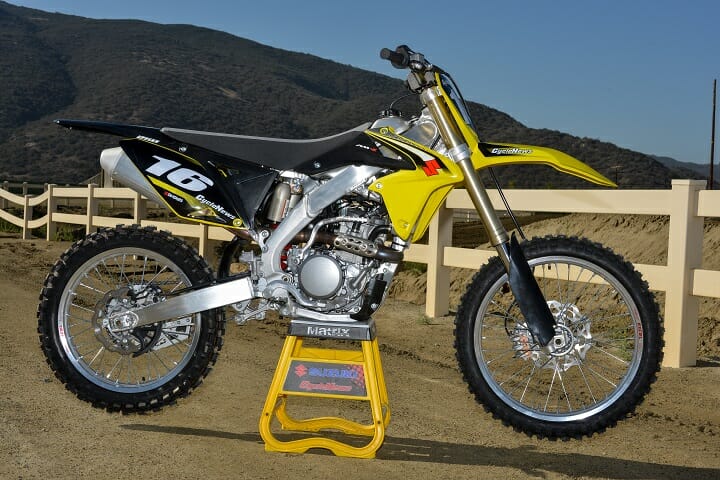
Despite its very familiar looks, the 2016 Suzuki RM-Z250 got a fairly significant upgrade, mostly to the engine. It also took on chassis changes and got a new KYB PSF2 air fork. The Suzuki is known for its outstanding turning abilities.
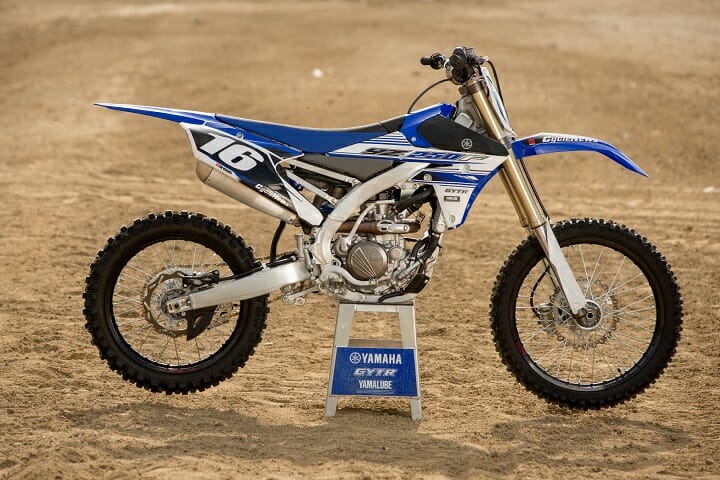
The Yamaha YZ250F is our defending shootout winner. Ever since its 2014 redo, Yamaha has been fine-tuning it wherever needed, and 2016 was no exception. It got some motor mods to give it a little better bottom end and midrange performance, and some suspension changes to give it ever better overall balance.
COUNTDOWN
6th Place – Suzuki RM-Z250
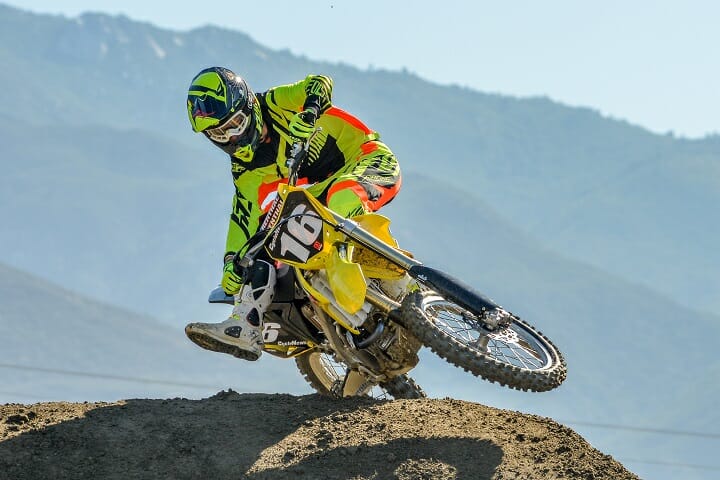
Despite its dated looks, the 2016 Suzuki RM-Z250 is one of the most changed bikes of the group, but it wasn’t improved enough to stay ahead of the even more changed and improved KTM or Husky, or the updated Honda and Yamaha. It did, however, gain ground on the once king of the class, the Kawasaki, so it dropped from third to sixth on our list compared to our 2015 shootout results.
The Suzuki is, however, a very good bike; it’s just that the bikes behind it last year—the KTM, Husky and the Honda—just got big-time better. The Suzuki is, however, improved over the ’15 RM-Z but just not as much as you think after all of the changes it got to the motor and chassis.
Overall, though, the Suzuki is still a very good motorcycle. Its motor has a more lively feel (not necessarily more powerful, though), and its new KYB PSF2 air fork is a big improvement over its previous Showa SFF spring fork. In fact, one of our test riders who flat out did not like the RM-Z last year actually loved the new one, ranking it high on his list, but he was in the minority with our many testers, who basically criticized the Suzuki for its comparatively weaker motor and heavier weight. The ’16 RM-Z still lags in the horsepower department compared to the other bikes, and our in-house dyno proved it. The RM-Z ranked the lowest at 35.60 HP @ 11,600 rpm. The Yamaha made 37.69 horsepower @ 12,200 rpm, the KTM 40.49 horsepower @ 12,400 rpm and the Husqvarna at 41.54 horsepower @ 13,800 rpm. The Honda is the closest to the Suzuki at 36.95 horsepower @ 11,600 rpm.
Vibration is a bit of a problem with the Suzuki, too.
At 235.5 pounds (full fuel), the Suzuki is the heaviest bike of the group, but not by much. It’s four pounds heavier than the lightest bike, the Yamaha, and a pound and a half heavier than its next-closest rivals, the Honda and Kawasaki. So it doesn’t bode well that the Suzuki is technically the “slowest” and the heaviest bike in its class, which are two very critical elements in the 250F category.
However, the Suzuki does many things well, like turning. It’s the best. In typical RM-Z fashion, the Suzuki gets in and out of the turns quicker than any other bike, and its new KYB PSF2 air fork works well, as does the back end. Suspension overall, however, is a little on the soft side and takes a bit more time dialing it in compared to the others, mainly up front, but that’s the norm these days with air forks.
Again, the Suzuki is an improved motorcycle and, in the big picture, a good one, too. Its great turning characteristic and solid chassis makes for a great supercross-style bike, but, overall, it just needs more power and less weight to really tickle our fancy.
Suzuki RM-Z250 Highlights
KYB PSF2 Air Forks
Plug-In Fueling Couplers
Aluminum Twin-Spar Frame
Tapered Aluminum Renthal Fatbar Handlebars
IMPORTANT NUMBERS
Max Horsepower: 35.60 HP @ 11,600 rpm
Max Torque: 18.16 lb-ft @ 9,200 rpm
Weight: 235.5 lbs
Seat Height: 37.6 in.
MSRP: $7,699
5th Place – Kawasaki KX250F
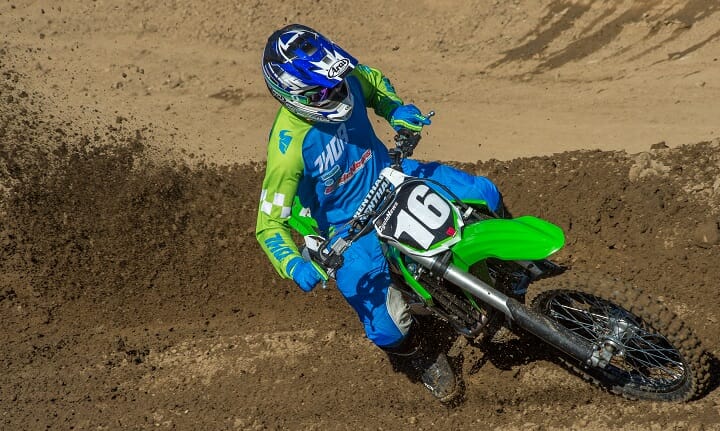
The Kawasaki is the least changed of the six bikes; in fact, it really hasn’t changed at all, just some minor visual changes, the new green (instead of white) rear fender being the most notable.
For a long time, the Kawasaki was the undisputed king of the 250 class, until the highly revamped YZ250F came along in 2014 and reduced it to prince status. But in its waning days of being king, pretty much all of the other bikes had been gaining ground on it in both the engine and chassis departments and without it getting any changes for 2016, some of the majorly redone bikes—like the KTM and Husky—have caught and passed it, including the further-updated Honda.
The Kawasaki, however, is still an amazing motorcycle, it’s well-known for its potent engine and rock-solid chassis, and nothing has changed, really, other than the other bikes getting even better engines and suspensions.
A powerful engine with a broad powerband still makes the Kawasaki a ripper on the track. It pumps out 38 horsepower at 12,500 rpm, which is very respectable, but savvy riders will better utilize the KX’s strong bottom-end and gutsy midrange within that wide spread of power. But if you like, you can ride it pinned with a lot of success, too. For a 250F, the motor is somewhat explosive, which makes it a bit of a handful at times and a little more difficult to ride smoothly consistently. This bike is also loud, loud, loud! You can also adjust mapping via Kawasaki’s new power tuner, which is sold separately. But Kawasaki still offers three plug-in couplers as standard equipment.
The KX’s unique Showa SFF spring fork, which houses a single spring in the left leg and all of the damping mechanisms in the right leg, is middle-of-the-road in performance, but is simple to dial in. We like that. The back end works well, too, but some of our testers said it just didn’t feel as settled as some of the other bikes, like the Yamaha and Honda.
Of the six bikes, the KX is probably our least favorite when it comes to cornering; it just doesn’t carve an inside line like the Suzuki, or any of the other bikes for that matter, but it rails the berms with confidence.
Overall, the KX250F is still an outstanding bike; it still has a very good motor, chassis and suspension, but just doesn’t feel as refined as the improved bikes ahead of it, nor is it the easiest bike to ride with its explosive motor and slower inside turning abilities.
Kawasaki KX250F Highlights
Showa SFF Type 2 Fork (spring)
Plug-In Fueling Couplers
Launch Control
Aluminum Perimeter Frame
Renthal Aluminum Handlebars
IMPORTANT NUMBERS
Max Horsepower: 38.23 HP @ 12,500 rpm
Max Torque: 18.91 lb-ft @ 9,100 rpm
Weight: 233.7 lbs
Seat Height: 37.2 in.
MSRP: $7599
4th Place – Husqvarna FC 250
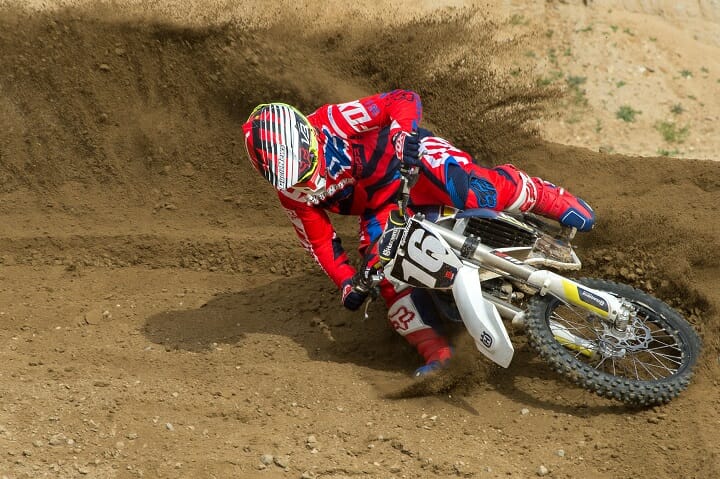
Okay, here’s when things start getting weird. When it gets down to it, the 2016 Husqvarna FC 250 and KTM 250 SX-F are essentially the same motorcycles. They roll off the same assembly line at the KTM factory in Austria and perform identically on the track; well, nearly identically. When our Husky test bike arrived, it already had a few more miles on it than our brand-new KTM test bike, so there was a bit of that freshness difference in feel, which might explain why some riders felt the two bikes felt a little different on the track, but when it gets down to it, these bikes are the same—except, for a few minor things, the most notable being the Husky coming fitted with Dunlop MX52 tires, the KTM MX32s; the Husky having a composite subframe, the KTM’s aluminum, and the Husky having a different airbox design. They also have different brake rotors, different clutch manufacturers and, of course, slightly different plastic and colors. On the scale, the Husky weighs about a pound and a half more than the KTM because of the heavier tires, subframe and plastic. Plus, the Husky has a tick more peak power than the KTM, which has to do with the different air box and subsequent airflow. (Both bikes share the same muffler, which isn’t the case with the KTM and Husky 450s.)
So why did the Husky get fourth and the KTM third? Because ties are no fun! Even hockey doesn’t have ties anymore (well, at least hardly anymore). Basically, it came down to tiebreakers, which are very minor: We like the MX32 tires on the KTM a little better, the KTM is a pound and a half lighter and costs $100 less! Hey, it has to boil down to something, right? Yes, the Husky makes a wee bit more power at ultra-peak levels, but we’ll take the lighter weight and smaller price over the tick extra power at a place in the powerband that you’ll never really notice.
For the sake of repeating ourselves, jump ahead to the KTM spread and read why these bikes tied, well, almost tied, for third place.
Husqvarna FC 250 Highlights
WP 4CS Spring Forks
Handlebar Mapping Adjustment
Launch Control
Electric Starting
Hydraulically Operated Clutch
Chromoly Steel Frame/Composite Subframe
Tapered Aluminum Handlebars
Dunlop MX52 Tires
IMPORTANT NUMBERS
Max Horsepower: 41.54 HP @ 13,800 rpm
Max Torque: 19.51 lb-ft @ 8,700 rpm
Weight: 233.5 lbs
Seat Height: 37.8 in.
MSRP: $8499
3rd Place – KTM 250 SX-F
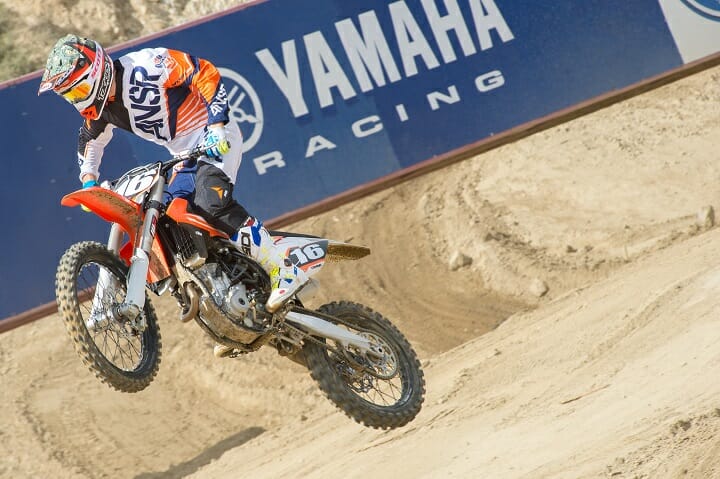
First of all, both the KTM and Husqvarna are all-new motorcycles. Everything on both bikes has been changed from their previous versions; they are essentially the same bike as the limited-edition 2014 KTM Factory Edition models.
There are a lot of things to like about the KTM (and Husky for that matter). The KTM has an outstanding motor that loves to be revved. It doesn’t quite hit as hard off the bottom as the Yamaha or Kawasaki, but does a great job of putting the power to the ground in the early part of the powerband before ramping up nicely as the Rs quickly build, and build and build and build, right up to its 40.49-peak horsepower at 12,400 rpm; the Husky keeps making a bit more power right up to 41.54 horsepower at an astronomical 13,800 rpm! If you’re the type of rider who loves to just hold the throttle wide open every time you twist it, these are your bikes.
Both bikes have a two-way controllable mapping switch on the handlebars (hard and soft) and launch control that is a little clunky to operate, so you’ll probably never use it. And we love their E-start buttons. Some question the use of electric starting on 250F motocross bikes, mainly because of its added weight and cost, but both KTM and Husky managed to keep weight low despite the added starter motor and battery, only the Yamaha is lighter. We also like the light pull and feel of their hydraulically operated clutches.
Handling is another strongpoint of the KTM and Husky. They are stable down the straights and turn nearly as good as the Suzuki, heck, maybe even equally as good! They lay over easily, ride through the ruts effortlessly, and are really good on off-cambers and slick corners. They also feel light and narrow between your legs and are very “flickable.”
Suspension is good and love the simple adjustability of the WP 4CS forks, which are quite good. Right out of the crate, suspension is a little soft, but for your average 250F riders, both the front and back suspension are setup from the factory in the ballpark.
And the brakes? None are better.
KTM 250 SX-F – Highlights
WP 4CS Spring Forks
Handlebar Mapping Adjustment
Launch Control
Electric Starting
Hydraulically Operated Clutch
Chromoly Steel Frame
Tapered Aluminum Handlebars
Dunlop MX32 Tires
IMPORTANT NUMBERS
Max Horsepower: 40.49 HP @ 12,400 rpm
Max Torque: 19.40 lb-ft @ 8,800 rpm
Weight: 232 lbs
Seat Height: 37.8 in.
MSRP: $8399
2nd Place – Honda CRF250R
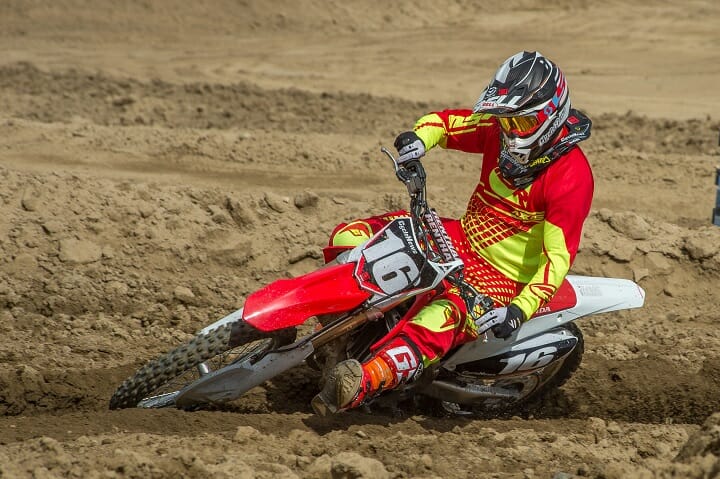
The Honda was by far the surprise bike of our shootout. We’ve always like CRF but wished for more power, which resulted in a fifth-place finish last year. Even though Honda made only a few changes to the Honda, most to the motor to give it more revs and top-end power, they were all of the right ones. As a results, the Honda simply wow’ed all of our test riders. It has two more horsepower than last year, yet still retains its already impressive low-to-mid performance.
The Honda makes good and very usable power across the board. It’s torquey off the bottom and has strong midrange performance and, even though it signs off before the KTM/Husky and Kawasaki on the dyno, it still feels great in the higher rpm range on the track. All of our testers simply agreed that the Honda has an extremely easy-to-manage engine, so what it may lack way at the top of the rev range, is made up elsewhere in usability. They also like the Honda’s easy-to-adjust, three-way adjustable mapping switch which is located on the handlebar. The “aggressive” setting was the setting of choice. Our testers also like the nearly vibe-free engine and quieter exhaust note.
The Honda already had one of the best suspension/chassis combos in the business and it only got better with the ’16 model. It has a very balanced feel and is just plain ultra comfortable between your legs. It also corners well and suspension is outstanding. Of all of the production air forks out there right now, the CRF250R’s Showa SFF TAC forks just might be the best, it has good feel and is one of the easier air forks to adjust and maintain.
The Honda also has decent brakes, excellent-feeling controls and like the Honda’s adjustable steering damper, which no other bike has. We’re still not sold on the dual mufflers but they’re easier to accept now when the rest of the bike works so well.
Plus, the Honda is one of the least expensive at $7,599. That’s $600 less than the Husky, and $500 less than the KTM. We figured that in, as well.
Honda CRF250R Highlights
Showa SFF TAC Air Forks
Handlebar Mapping Adjustment
Aluminum Twin Spare Frame
Dual Exhaust System
Unicam Valve Train
Dunlop MX52 Tires
IMPORTANT NUMBERS
Max Horsepower: 36.95 HP @ 11,600 rpm
Max Torque: 19.09 lb-ft @ 8,900 rpm
Weight: 234 lbs
Seat Height: 37.4 in.
MSRP: $7,599
1st Place – Yamaha YZ250F
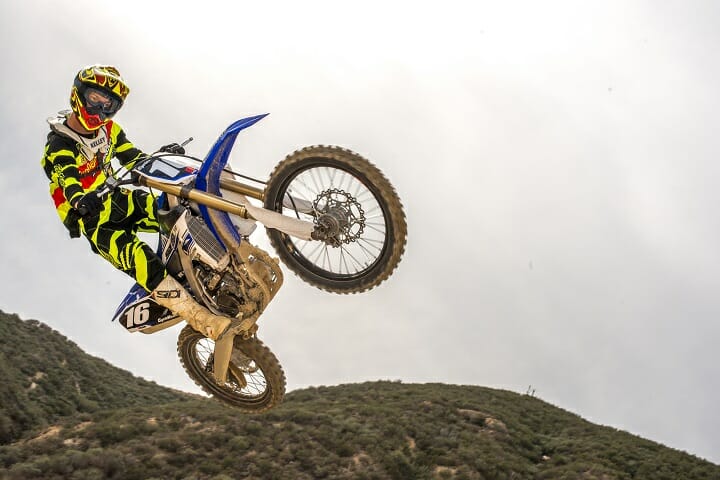
As good as all of these bikes are, it still amazes us how the YZ250F can still dominate our shootouts like it has ever since its 2014 overhaul. All but one of our test riders picked the YZ as their top dog of the six, the only one who didn’t pick the Yamaha picked the Honda, but even that person—a novice-skilled rider—was super impressed with the YZ.
The Yamaha isn’t perfect by any means—it’s not the most powerful bike in its class, it’s not the best turning bike, and it’s not the slimmest bike out there, but, holy fork oil, as a complete package, the Yamaha is awesome! It is the lightest bike of the six, has the best overall suspension and it boasts the cheapest MSRP (okay, by only $9 over the Honda but, hey, technically it’s the cheapest at $7,590. That’s great marketing.)
As mentioned, the YZ doesn’t win any peak-horsepower awards, but still divvies out a respectable 37.69 HP @ 12,200 rpm. However, it’s how the Yamaha distributes that 37 HP that makes the YZ’s engine so special. From bottom to top, there’s useable power everywhere, which makes the YZ a great bike for both the pro and novice rider. Overall, this bike rips.
Mapping can only be changes via Yamaha’s power tuner, which you have to purchase separately, but we won’t hold that against them because the tuner is easy to use and your adjustability options are pretty much limitless.
And the YZ has the chassis to keep up with the engine. The SSS spring fork are still the best in the business, it has great performance and consistency, and is super-easy to dial in. The shock follows suit. Overall, the YZ has a plush feel and shines on rough tracks, rougher the better.
The Yamaha has solid, stable and predictably handling. It rarely does anything scary or surprising; you can really change hard over the rough stuff with confidence. It might not be the sharpest-turning bike of the six, but it turns good enough.
What else can we say, really? The YZ250F just plain works. It’s fast, it handles well, it has great suspension and it’s also the only bike that is offered in two color combinations—blue/white and old-school yellow/black, and both look sweet!
Without hesitation, the Yamaha YZ250F is, for the third straight time, our 2016 Cycle News 250F MX Shootout winner. It still the best bike in its class. Period.
Yamaha YZ250F Highlights
KYB Speed Sensitive System (SSS) spring forks
Reverse Cylinder Design
Rearward-Inclined Cylinder
Aluminum Frame
Tapered Aluminum Handlebars
Two Color Options (Blue, Yellow)
MPORTANT NUMBERS
Max Horsepower: 37.69 HP @ 12,200 rpm
Max Torque: 18.58 lb-ft @ 8,700 rpm
Weight: 231 lbs
Seat Height: 38.0 in.
MSRP: $7,590
You can read the original magazine story by clicking HERE.
For more Cycle News Motocross motorcycle reviews, click HERE.
For more Yamaha motorcycle reviews, click HERE.